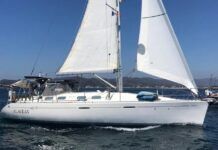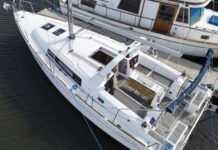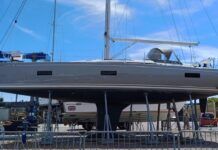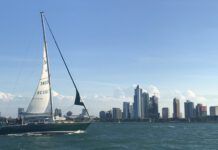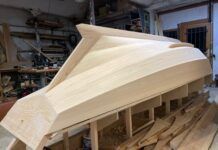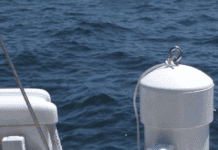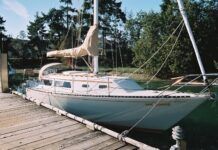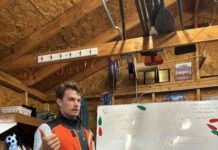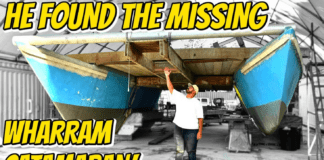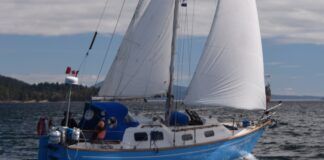The December, 1993, issue contained an in-the-water test and evaluation of 16 different Type IV life preservers (cushions, horseshoes and ring buoys). Besides their throwability, flotation and the ease with which a person in the water can get to and utilize them, an important consideration was said to be how quickly these Coast Guard-required “throwables” can be detached from the boat and made available to the man overboard.
Because rapid deployment is so vital, the manner in which a horseshoe or ringbuoy is carried on the boat is important. We collected a dozen mounting devices, for both horseshoes and rings. There’s a great variety of types, from rather complicated to very simple. They range inprice from $4.99 to $79.95!
We closely examined and tested each for their sturdiness. Also considered (because they tend to be ignored for years) is their ability to stand up to constant exposure. Most importantly, we wanted to know which ones se curely hold a throwable yet permit, with minimum effort, very quick re lease. Although it may be mentioned, no consideration was given to the difficulty or time required to assem ble or attach the mounts; that’s a one time chore.
We’ll not make a chart of these mounts, which we’ve divided into four groups: Wire racks; three quick-release types; two strap models, and three odd ones. All are available through chandleries, marine discount or manufacturers’ catalogs.
Wire Racks
All four of the wire rack-type holders are intended for horseshoes. Two are manufactured by Cal-June (Jim Buoy), one is from Forespar and the fourth is made by S&J Products of Chicago, Illinois. All are built of quarter-inch stainless rod.
After trying them all repeatedly, we decided that we disliked the “two rectangles” Cal-June model, which mounts with hose clamps. Each of the two versions (one for the standard horseshoe, the other for the Jim Buoy Pony) sells for $10.25. The weldments are a bit crude and there was no at tempt made to polish off the weld discoloration. However, our rejection of this model has to do with the difficulty of getting the horseshoe free of the rack, especially if the horseshoe, cooking in the sun, has taken a “set” in the wire rack. One must stand almost over the horseshoe, which is forced into the rectangles, in order to yank it free of the mount. The resulting tightness of the fit appears to be a very undesirable feature. If you use this rack aboard your boat, try getting the horseshoe free.
The $20 Cal-June circular rack (for standard or “pony” horseshoes) is better. It has a curved portion of the wire that fits over the top of your stern pulpit, but you’ll need a hose clamp or tie-down below. On the top, to hold the horseshoe in the rack, there is a plastic retaining strap with an inch square bit of Velcro. The strap must be freed before the horseshoe can be lifted and dropped. We suspect the plastic strap would survive only a few seasons in the sun.
The $20 S&J rack, an unusual shape, also fits over a horizontal section of the pulpit, with a hose clamp or tie-down below. It has a nasty peculiarity. It looks clever, but isn’t. Because of its shape, the horseshoe must be lifted and turned about 60 degrees before it can be freed from the rack. That’s why it needs no retaining strap. Quick deployment of the horseshoe would be difficult in an emergency, particularly for someone unaware of the rack’s idiosyncrasy.
None of the above three racks come with hose clamps, a pair of which would add a couple of bucks to the price.
The best metal rack (which, of course, costs the most at $35) is the small, simple Forespar Model 300-H (or 300-R for ring buoys), which accommodates either a horseshoe or a ring. It has Forespar’s patented Rail-fast mounting bracket, made of nylon with a metal strap to encircle the pulpit or a stanchion. The metal clamp, with a shim to make it usable for either 7/8″ or 1″ rails, even has an abrasive on the inner surface to assure a firm grip. It comes with an Allen wrench for attachment, which requires a bit of effort. The one-piece wire bracket can be bent to provide pressure to hold the horseshoe in place and still permit it to be lifted about five inches and dropped quickly.
Quick-Release Types
As differentiated from racks, which require the user to lift the horseshoe or ring to free it, the quick release brackets are defined by their ability to simply drop a horseshoe or ring with the pull of a small line, pin or strap.
All three of our examples are made by Forespar, which takes the safety business very seriously.
Forespar’s Fabric Launcher has the virtue of being “soft,” with no sharp hose clamp edges. There’s nothing that will get bent or corrode, but it needs to be lashed carefully to the pulpit with small stuff. It is an assembly of UV-resistant fabric flaps, with a stiff plastic base (to hold a strobe light). It’s slightly complicated to rig. Starting with the fabric flat, the horseshoe is placed in position, the flaps are folded in and a light line is used to draw bits of sewn-in shock cords through brass grommets. Three stainless steel pins affixed to a single piece of 1/8″ cord then are inserted in the shock cords. The horseshoe is instantly deployed when you pull the three pins free by yanking on the cord. It is a well-made, secure, lightweight device. Unfortunately, it costs $95 list and isn’t carried in any discount catalog we could find.
Forespar’s HLD-1 horseshoe launcher is a clever, two-piece poly ethylene device that resembles a toilet seat. The horseshoe fits nicely over the base molding. The other molding, a retaining cover of sorts, is held in place by two studs in the base and, at the top, a shock cord held in place by a release pin. Pull the pin and the horseshoe drops in the water. A light, dye marker, whistles and a length of line can be stored inside, attached to the buoy with supplied pins, and there are fastenings to attach a backstay or tube-mounted pole (with the butt seated in a recess in the molding, all of which would be deployed with a single pull of a pin. There’s also a molded-in place to carry a pole in a horizontal position. The HLD-1 costs $80. It makes a very neat and surprisingly inconspicuous (but not easy) installation and makes the most sense if you intend to add the peripheral equipment.
For a really simple way to mount a horseshoe, Forespar’s “Quick Trip” launcher is small and cheap. It’s Forespar’s best seller. Merely an anodized aluminum mounting plate (with rectangular slots for hose clamps or lashings) with a strap of sturdy fabric, The “Quick Trip” has a stainless snap fastener (two positions for horseshoe or ring buoy). Pull the strap and in goes the horseshoe. One might wonder what will happen in time to the stainless fasteners in the aluminum plate. But if you keep a dab of silicone on the snap to make sure it doesn’t corrode, for $24.95 list, Forespar’s Model L- 100 shouts “Best Buy!” of all.
Strap Holders
The Garelick Manufacturing Company in Minnesota makes two moderately-priced holders, one for horseshoes, the other for rings, in two sizes (7/8″ or 1″). Both are vinyl-coated aluminum brackets with plastic mountings that fit either horizontally or vertically. The two mounting bolts and the snap fastener on the web strap are stainless steel. The tail of the web strap is a bit short for easy gripping. Neither the mountings nor the snap fasteners match the quality of the Forespar equivalents, but the ring mount goes at discount for about $15 and the horseshoe mount, the same design but wider, with two plastic mounts, is $20. With these holders, which are called EEz-In, you must release the strap and lift the horseshoe or ring free. Despite the fact that the vinyl sooner or later will crack and peel, the inexpensive Garelick holders aren’t bad. However, we greatly prefer either the Forespar fabric “Quick Trip” or the small Forespar wire rack with its Railfast mounting.
Odd Ones
While gathering up all this gear, we acquired three mounts we’re calling “odd ones.” That’s being kind.
From Cal-June, for about $6 discount, you can buy a pair of 3/4″ anodized aluminum straps, bent to roughly fit a ring buoy, with two holes punched in each piece (no mounting screws furnished). Because they’re meant to be spread-mounted at about 30-degree angles, they are useful only on a large flat surface. To use them on a sailboat pulpit, they’d require a mounting board. They’re not shown in the photographs.
Also from Cal-June is a huge, heavy (9 lbs.) holder made from pieces of spot-welded aluminum plate. It is specifically for the Cal-June Rough neck ring buoy, but would work for any 30-inch ring. We can’t visualize this holder on anything but a trawler or motor yacht. It costs $49 discounted. A package of four U-bolts to mount the thing costs another $5.
Finally, a bad joke from Italy: A permanent mounting for a life ring.
We ordered from the Defender Industries catalog the $18.95, one-piece polyurethane ring holder. It is marked “Ocean.” Inside the strap, it says “Made in Italy, Patented.” It has molded-in grooves to force it on a pushpit rail or stanchion. To hold a ring buoy, there’s a strap (with transverse grooves on the underside) that fits into a buckle (with transverse teeth). However, when we tried it, the strap, once inserted in the buckle, would not release. It was possible to free the strap by inserting a finger to disengage the grooves, but only if the ring buoy was not in place.
The Bottom Line
For either a horseshoe or ring buoy, we like the simple Forespar “Quick Trip” fabric strap. If the fabric or hardware show signs of deterioration in five years, replace it with a new one. If you prefer something metal, Cal-June’s circular mount for a horseshoe is adequate and thrifty, but our choice would be either Forespar’s Model 300- Rs for a ring buoy or a single Model 300-H for a horseshoe. For a quick release type for a horseshoe, it’s a toss up between Forespar’s light, all-fabric holder or, if you intend to go for a pole and light, the longer-lasting plastic Model HLD-1.





